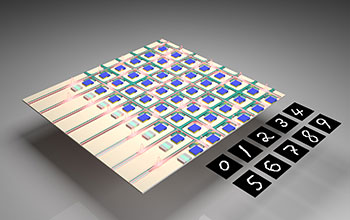Multimedia Gallery
'Handwritten' numbers generated by integrated optical computing chip
An illustration of an integrated optical computing chip and "handwritten" numbers it generated. The chip contains an artificial neural network that can learn how to write in its own distinct style. The system uses "noise" (stray photons from lasers and thermal background radiation) to augment its creative capabilities and is approximately 10 times faster than comparable conventional digital computers and more energy efficient.
[Research supported by U.S. National Science Foundation grants CNS 1955196, CCF 2105972, ECCS 1542101 and ECCS 2025489.]
Learn more in the University of Washington news story Harnessing noise in optical computing for AI. (Date of image: Jan. 2022; date originally posted to NSF Multimedia Gallery: Nov. 19, 2022)
Credit: Seokhyeong Lee, Department of Electrical and Computer Engineering, University of Washington
Images and other media in the National Science Foundation Multimedia Gallery are available for use in print and electronic material by NSF employees, members of the media, university staff, teachers and the general public. All media in the gallery are intended for personal, educational and nonprofit/non-commercial use only.
Images credited to the National Science Foundation, a federal agency, are in the public domain. The images were created by employees of the United States Government as part of their official duties or prepared by contractors as "works for hire" for NSF. You may freely use NSF-credited images and, at your discretion, credit NSF with a "Courtesy: National Science Foundation" notation.
Additional information about general usage can be found in Conditions.
Also Available:
Download the high-resolution JPG version of the image. (984.6 KB)
Use your mouse to right-click (Mac users may need to Ctrl-click) the link above and choose the option that will save the file or target to your computer.

